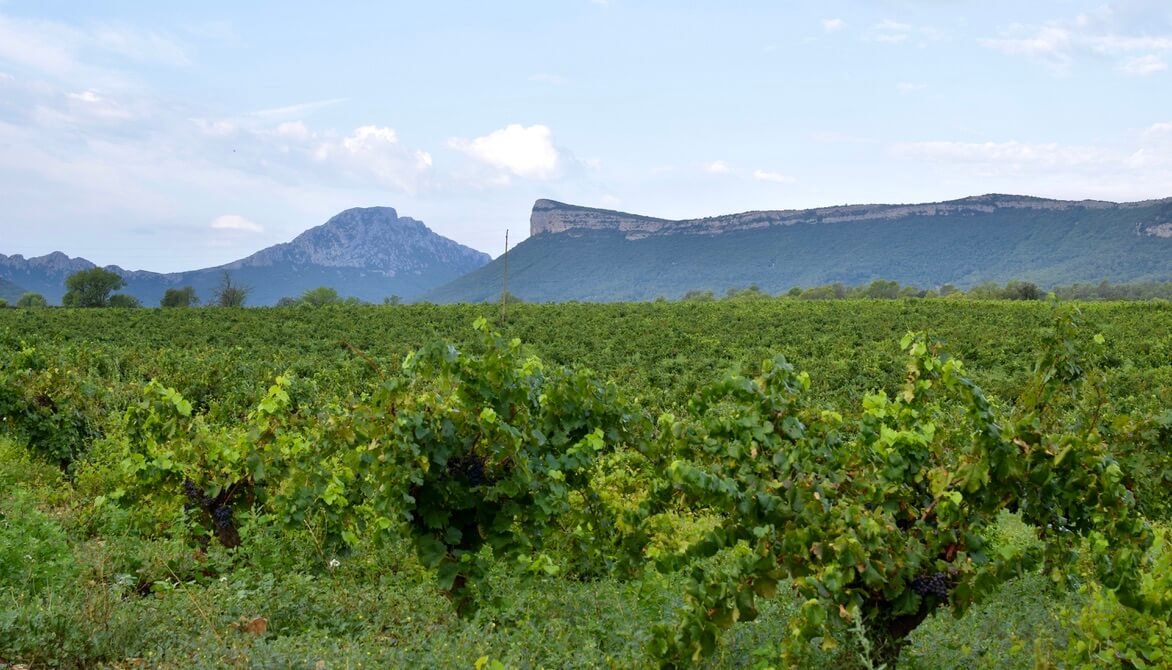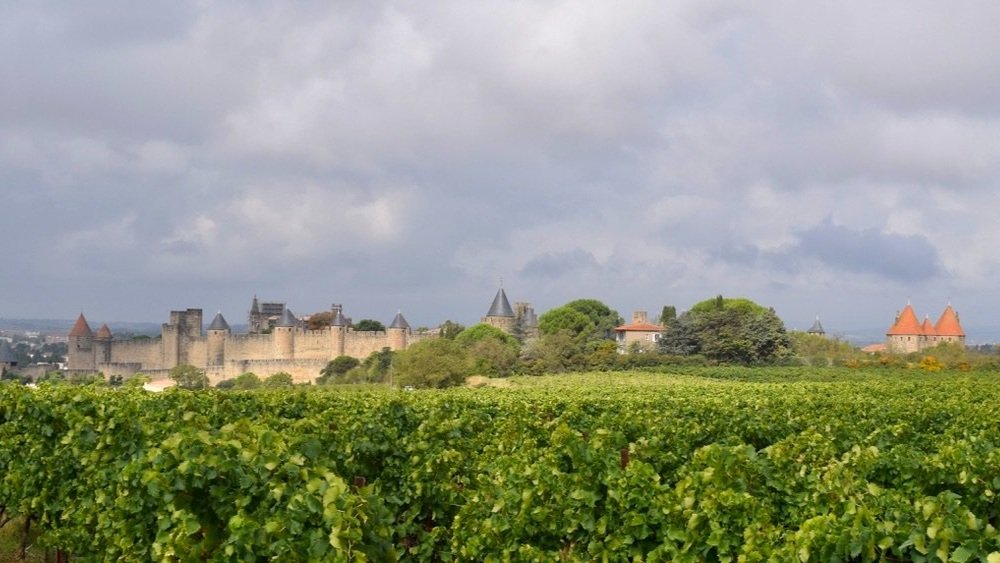FRANCE’S LANGUEDOC-ROUSSILLON WINE REGION

Pic Saint Loup - Eastern Languedoc
Photo source: Winekeller
Our wine tour experiences in France’s Languedoc-Roussillon wine region:
France’s Languedoc-Roussillon wine region: an introduction
The wine region of Languedoc-Roussillon (popularly known as Languedoc), in the south-west of France, stretching out along the Mediterranean and in the foothills of the Massif Central and Pyrenees, is one of the largest, most varied and exciting of the French wine regions. Although it still accounts for somewhere between a quarter and a third of all French wine production, the focus in more recent years is on ‘quality’, not ‘quantity’.
This large and diverse wine region is still recognised as ‘Languedoc-Roussillon’, but in 2016 the administrative area was merged with the neighbouring Midi-Pyrénées region to form the super-region - ‘Occitanie’. Today the Languedoc-Roussillon wine region is made up of 3 sub wine regions, stretching from south of Toulouse to Nîmes in the east and right up to the Spanish border on the coast in the west - Western Languedoc, with Narbonne, the mediaeval walled city of Carcassonne and the département of Aude at its core, Eastern Languedoc, with vineyards spread across the ‘département’ of Hérault and around Montpellier and Roussillon, ‘Catalan’ country, at the eastern end of the Pyrenees.
Dynamic, innovative vignerons are attracted to the region by the near-perfect vine growing conditions and many Languedoc-Roussillon wineries are now practicing organic or biodynamic winemaking processes. Wines often represent excellent value for money - superb quality, without the price tag of the more famous French wine regions.
Languedoc-Roussillon is a very popular destination for wine tourists, with its spectacular and varied scenery and landscapes, its warm, dry climate, its vivid history, its famous gastronomy and of course its varied, excellent wines.
Vineyards around St. Hilaire, Limoux, W. Languedoc
Vineyards at Banyuls, Roussillon
Malapère vineyards near Carcassonne
Picpoul vineyards, E. Languedoc
Languedoc wines & Roussillon wines
Languedoc-Roussillon features a typical Mediterranean climate with very hot, dry summers, winds but little rain and it benefits from fresh influences from the Atlantic in the far Western Languedoc.
Languedoc vineyards are located on the coastal plains of the Mediterranean as well as in rugged, mountainous terrain. A large proportion of the land here is known as ‘garrigue’ – a French term which describes the hot, dry, low-lying scrubland on limestone soils. This is perfect vine ‘terroir’ and is some of the reason why vines have flourished in this French wine region over the years.
The Roussillon landscape is somewhat softer than the more rugged Western Languedoc, with some 325 days a year of sunshine.
Languedoc-Rousillon wine map
Source: Château de Pennautier, Lorgeril
Red wines:
Almost 80% of Languedoc wines are red - which are characterised by rich, spicy, full-bodied red wines made from mostly Syrah, Grenache, Carignan, and Mourvèdre grapes. These excellent wines can often really compete with the higher priced, more famous French reds. These same grapes also produce some very fruity and often quite ‘trendy’ rosé wines.
White wines:
More sophisticated white wines are now being produced by Languedoc winemakers, often featuring blends of Picpoul, Grenache Blanc/Gris, Viognier as well as the lesser known Roussanne, Vermentino, Marsanne, Bourboulenc, Maccabeu and Clairette. An area around Maury in the Agly Valley in the Roussillon region, is becoming increasingly respected for its dry, distinctive white wines.
Sparkling wines:
Languedoc is also known for its excellent sparkling wines, mostly from AOC Limoux in Western Languedoc. Crémant de Limoux is said to have been invented before Champagne and often provides exceptional value for money. Blanquette de Limoux, also produced by the Traditional Méthode, is popular too around the world.
Sweet wines:
Languedoc-Roussillon produces some amazing sweet, aromatic wines called ‘Vins Doux Naturels’ - where fermentation is stopped through adding alcohol (as in Port production). The Rousillon region constitutes 90% of France’s total production of these special sweet wines.
Red grapes, Carbadès W. Languedoc
Vins Doux Naturels, Banyuls
Pic Saint Loup, E Languedoc
Terrasses du Larzac, E Languedoc
Languedoc-Roussillon appellations
Much of the region can produce inexpensive IGP Pays d’Oc wines or IGP Côtes Catalanes wines.
In terms of appellations, many vineyards qualify for the basic Languedoc (especially Easter Languedoc) and Côtes du Roussillon appellations, but there are several other key ones, which are now featuring more on international restaurant and retail wine lists, including:
Western Languedoc appellations:
Minervois - producing some excellent, serious reds
Muscat de St-Jean de Minervois - producing sweet, aromatic wines from the Muscat grape in the ‘Vin Doux Naturel’ style
Corbières - dramatic, mountainous landscape producing some powerful reds, less elegant than Minervois
Fitou - much smaller area than Corbières, producing excellent reds, featuring Grenache and Old Carignan grapes
St-Chinian - excellent reputation for fine white, red & rosé wines
Limoux - cooler climate, producing wines with greater acidity - an AOC for red/white wines, a separate AOC for sparkling wines and ones for AOC Blanquette de Limoux, Blanquette de Limoux Méthode Ancestrale and Crémant de Limoux
Eastern Languedoc appellations:
Faugères - distinctive red, white & rosé wines
Picpoul de Pinet - very fashionable and the most successful Languedoc white wine - an old southern French grape
Terrasses du Larzac - fairly new appellation producing some noteworthy wines
Pic St-Loup - a relatively new appellation, refined, distinctive wines
Roussillon appellations:
Côtes du Roussillon-Villages - superior classification to Côtes du Roussillon - bolder, stronger reds
Banyuls & Collioure - vins doux naturels sweet wines, robust reds (mainly Grenache, Syrah & Mourvèdre) & strong whites
Maury - excellent whites from the vineyards in the Agly Valley and some red vins doux naturels

Spectacular Carcassonne - Photo source: Winekeller
Recommended Languedoc wineries
See our blog articles for recommended Languedoc-Rousillion wineries.
Visiting France’s Languedoc-Rousillon region - Travel guide and other useful information
Getting there
Languedoc-Roussillon in the south-west of France is easy to get to by road, with the main motorways feeding there from Paris, Lille, Strasbourg, Nancy, Lyon, Geneva and Barcelona. Toulouse is the nearest major airport, but there are also airports at Béziers, Nimes, Montpellier, Carcassonne and Perpignan. The train from Paris to Narbonne takes 4 hours.
Enjoying the Mediterranean coast
Languedoc has plenty of coastline to enjoy, with sandy beaches, marinas and small ports. Tourist developments sprung up in the 60s and 70s, including resorts such as Cap d'Agde, Palavas, or Narbonne Plage and the fishing and commercial port of Sète is worth a visit for its old town, beaches and boat trips.
The coastline where the Pyrenees meet the sea in the Roussillon region, close to the Spanish border, is unlike the rest of the Languedoc coast, and is characterised by old coastal villages such as Banyuls and Collioure, rocky cliffs and small coves. There is a stunning sandy beach close by in Argelès-sur-Mer.
The beautiful port of Collioure
Banyuls with its vines & pretty coves
Beach at Argelès-sur-Mer
Explore Languedoc’s fascinating history
Languedoc is steeped in history and tradition. The name ‘languedoc’ gives you a clue - translated as ‘the language of Oc’, which used to be the predominant language in the region. Much of Languedoc is ‘Cathar country’ and as such there are many incredible towns, cities, villages and historic monuments that witnessed the sieges and massacres that marked the area's turbulent history in and around the twelfth and thirteenth centuries. The "Cathars" were followers of a dissident church that flourished in several parts of Europe during the early Medieval period and the movement flourished here in the southern half of the French region of Occitanie (Languedoc and Midi-Pyrénées).
Make sure you visit the walled, historic city Carcassonne, a UNESCO World Heritage site, encircled by medieval ramparts. You can also visit the area’s medieval castles - of special note are the castles of Quéribus and Puylaurens. Also take time to visit the old Languedoc city of Béziers, the former Roman cities of Nîmes and Narbonne, Montpellier and the fully walled city of Aigues Mortes near the coast.
The walled city of Aigues-Mortes
‘Cathar country’ - a turbulent past
Place de la Comédie, Montpellier
Experience Catalan country
Roussillon’s inhabitants consider themselves Catalans, not French. You can experience this through the food, trying to decipher the local dialect and enjoying the sights of the distinctive Catalan boats in the pretty ports with their yellow and red striped banners!
Other recommended attraction in Languedoc
Le Canal du Midi - a UNESCO world heritage site and the world's oldest commercial canal, built in the 17th century. Shaded cycleway and footpath linking the Mediterranean and the Atlantic.
Le Pont du Gard - Another UNESCO World Heritage site, an impressive Roman aqueduct, just northeast of Nimes.
Gorges du Tarn - a dramatic and deep gorge in the river Tarn.
Languedoc-Roussion’s amazing gastronomy - what to eat with your wine!
Typical Southern gastronomy is a serious subject! There are many different food influences, for example the proximity to Spain and Catalan country, the coast and the mountains. Here are just some of the more traditional dishes you can try in Languedoc Roussillon:
The hearty cuisine of the Haut Languedoc is characterised by the use of pork and bird fat, especially duck, and perhaps the region’s most famous traditional dish is a bean ‘cassoulet’, made with sausage, pork or lamb, with duck or goose confit. Gardiane is another popular, rustic dish – a beef stew with red wine and served with rice.
The Catalan influence can be found in regional dishes such as brandade which is made from a purée of dried cod, crème Catalane (like a crème brulée but more delicate) and morue à la Catalane – a cod dished served with tomatoes and pepper and anchoïade – anchovies with garlic and olive oil. Snails are also popular and are prepared in a specific Catalan style known as a cargolade – grilled in their shells with salt, pepper, and herbs or lard.
Seafood forms an important part of the local cuisine - sea bream, mussels, red mullet and squid are flavoured with locally produced olive oil, tomatoes, garlic, onions and aromatic herbs. Regional delicacies also include oysters and bourride – a spicy fish with aioli.
Traditional, hearty Cassoulet
Fresh fish from the Mediterranean
Where to stay in Languedoc
See the following websites for more information about where to stay, the history and what to see and do in Languedoc-Roussillon.














Read about our visit to a wonderful winery and wine tourism destination, Château de Jonquières, the oldest family wine estate in Languedoc, located in the Terrasses du Larzac appellation - part of the beautiful Easter Languedoc wine region…..